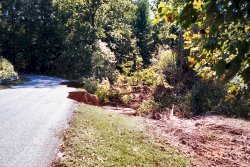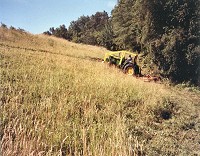
 Department of Conservation and Recreation
Department of Conservation and Recreation
Conserve. Protect. Enjoy.
 Department of Conservation and Recreation
Department of Conservation and Recreation

With proper care, earthfill embankment dams have proven to be very effective for many years. Most embankment dams are composed of non-organic material and do not deteriorate appreciably with time. An embankment may even continue to undergo additional consolidation and strengthen with age, once the critical points of initial settlement and initial reservoir fill have passed. Nevertheless, the continuing safety of any embankment dam depends on the integrity of its earthen fill to withstand pressure from the volume of water in the reservoir.
The biggest enemy of any earthfill dam is erosion, either external (water overflow creating ruts or rills on the surface of the fill) or internal (sometimes called "piping"). External, or surface, erosion is generally obvious if one takes the time and effort to look over the dam carefully. Internal erosion is not readily visible and may not be detected until it is too late for corrective action. This can result in an emergency situation and even lead to a catastrophic failure.
A dense cover of low-growing grassy vegetation is recommended because it will provide protection from surface erosion, but its root structure does not penetrate the embankment so deeply as to create a potential path for internal erosion.
The type of grass and its fertilization should be appropriate for local conditions. The proper vegetation should be established and maintained over the entire embankment, outlet, plunge pool and spillway area. Coverage should extend at least 25 feet beyond the abutment contacts and toe of the fill. Regular mowing throughout the year is essential so that the surface can be readily traversed by foot. Potential dam safety problems, such as misalignment, cracks, animal burrows, surface erosion, seepage, sloughing, etc. can be spotted early enough to take corrective action. Therefore, mowing should precede each dam inspection.

Although woody vegetation such as trees and brush may protect against surface erosion, such growth can cause other, serious problems. These problems develop over years and may go undetected until it's too late. In addition, trees or brush can hide an embankment surface, making inspection difficult.
When trees die, it causes the roots to decay, leaving a cavity within the dam. Water leaking through such a cavity can produce a piping failure. In addition, a tree can be blown over during a severe storm, leaving a large hole in the dam in place of the uprooted root ball.
Because tree root problems occur over a long time, even decades, they often go undetected. Many times, dam failure is described as a sudden event when in fact conditions leading to the failure went undetected or ignored for years.
Trees should never be allowed to grow on the embankment fill, at the outlet, plunge pool or spillway area, or within 25 feet beyond the abutment contacts and toe of fill. Any tree on a dam should be removed, its roots grubbed out and dense grass cover established in its place. Deviation from this standard must be based on a critical assessment by a professional engineer who specializes in dams.
Follow the general guidance below:
| Condition | Action needed |
|---|---|
| Existing dam with trees | Cut and remove all trees. Grub out all roots larger than 1 inch in diameter. Grade to adjacent contour and establish cover as described below. |
| New dam or existing dam without trees | Establish and maintain dense cover of grass. Maintain a height of 4 to 8 inches with regular mowing to discourage growth of woody vegetation and to facilitate visual inspection for seepage, sloughs or other signs of stress. New dams should have no trees on them. |
A question dam owners often ask is, "Why can't I just cut down the trees at the surface, and then keep the vegetation properly controlled in the future?" This may be acceptable for Low Hazard dams if and only if accompanied by a commitment to very carefully monitor the dam and to be prepared for immediate emergency action. Eventually, however, it will be necessary to deal with the decaying roots. In other words, a decision to just "cut and watch" simply postpones the dealing with the underlying problem and may result in an emergency situation or even failure of the dam.
Removal of trees and roots on High and Significant Hazard dams must be done under the direction of a professional engineer. After cutting and removing all trees and brush, all roots should be grubbed out to assure that no roots larger than 1 inch in diameter remain. Generally, the reservoir needs to be lowered prior to grubbing the roots. The rate of decrease in the reservoir level should not exceed 6 inches per day unless otherwise directed by a professional engineer. Holes resulting from the grubbing operation should be backfilled with well-compacted soil. Upstream slopes should be backfilled with impervious soil, while more pervious soil may be used on the downstream slope. The backfill should then be graded to blend with the surrounding contour, and appropriate grasses should be established on all disturbed areas.
Trees on dams are a serious safety hazard. There is no single "cookbook" solution on the proper way to remove them . . . each case is unique. The advice of professional engineer needs to be sought and followed.
Contact DCR's Dam Safety Program staff at (804) 371-6095
or email dam@dcr.virginia.gov.

